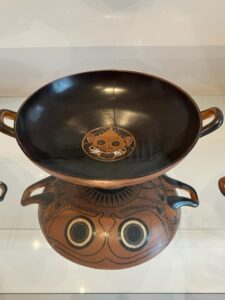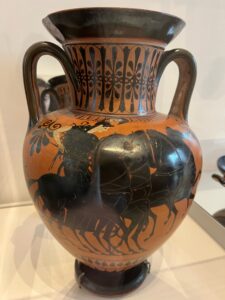
Name and Creator: Gorgon and the Eyes of Dionysus on a Red-Figure Kylix -Type B (Wine Cup). While the creator of this kylix is unknown to historians, it is known that it was constructed “in the manner of the Lysippides Painter.” The Lysippides Painter was a famous Athenian black-figure vasepainter whose identity is a mystery. As an artist, the Lysippides Painter was well-known to have a distinctive art style that matches this kylix. However, considering that this wine cup was made circa 430 BCE which was before the time period that the Lysippides Painter was known to be active (around 530 to 515 BC), it may be wrong to assume that the Lypippides Painter created this kylix.
Date of Creation: This piece of art was created circa 430 BCE.
Location on Campus: This red-figure kylix is featured in the Greco-Roman Art Exhibit of the Blanton Museum of Art.
Acquisition: This art piece became part of the Blanton Museum of Art on UT’s and the James R. Dougherty, Jr. Foundation. While the Huntington Fund contributed $600,000 out of the $1.5 million over the course of thirty-five years to open the original Art Building with the Archer M. Huntington Gallery in 1963, the James R. Dougherty, Jr. Foundation has worked to fund endowments and innovative projects since its establishment in 1950.
Type of Art Work: The Gorgon and the Eyes of Dionysus on a Red-Figure Kylix – Type B (Wine Cup) is a Greek-Attic red-figure vase painting on a terracotta kylix, 3 3/8 Å~ 8 7/16 in. (8.5 x 21.5 cm) overall.
Description: In this work of art, the cupped portion of the kylix that holds the at the very center. The particular female Gorgon shown here seems to be Medusa as reflected by the unique portrayal of her defining characteristic: her serpentine locks of hair. At the wide base of this wine cup, there are two large, prominent eyes, rumored to belong to Dionysus or the Gorgons, gazing intensely at the holder of the kylix. Surrounding these eyes, there are graph vines spiraling everywhere that frame the rest of the base of the kylix.
In Greek mythology, the Gorgons, which roughly translates to “the terrible ones,” were three powerful and winged sisters: Medusa (Guardian), Euryale (Wide-stepping), and Sthenno (Strength). In ancient Greek art, these winged bestial women were commonly portrayed with round heads, large staring eyes, protruding tongues, and sharp tusks resembling those of swine (Curtis). All of these characteristics can clearly be seen in this kylix. Moreover, the Gorgon that is the depicted on the kylix is adorned with snake-like coils around her head as hair, indicating a serpent motif, lending us to identify her as Medusa as in most well-known myths. However, it is important to consider that this does not necessarily imply that the artist believed Gorgons had snake-hair. The serpent element in the sculpture likely signifies the Gorgons’ status as chthonic deities, where snakes or dragons often represent the divine and uncivilized nature of sacred places in Greek mythology (Curtis).
Unlike her sisters, Medusa was describes as being the only mortal Gorgon (Hesiod’s Theogony 276-278). Interestingly, she was also described as a beautiful woman by late classical poets who believed she was turned into a monster by Athena as punishment for having sexual relations with Poseidon in her shrine (Atsma – Gorgones). In contrast, earlier Greek writers and artists portray her as a monster who was born into a family of monsters. The portrayal of the latter can be seen in this red-figure kylix.
Another important figure in Greek mythology that can be seen on this ancient wine cup is Dionysus. As the Olympian god of wine, vegetation, pleasure, festivity, madness, theater, and wild frenzy, Dionysus was depicted as either a young or old man who was commonly seen with a thyrsos (a pine-cone tipped staff), a drinking cup and a crown of ivy in Greek paintings and vases (Atsma – Dionysus). Moreover, he was also shown to be flocked with Satyrs and Maenads and surrounded by grapevines. While most of these characteristics are not reflected in this kylix, there are several allusions to Dionysus’s sphere of influence, wine, that tie into the meaning of the artwork.
There are numerous interpretations that can be made regarding the intended symbolic meaning of this work of art. Being placed strategically on the wine cup, the menacing face of the Gorgon, Medusa, is intended to turn away evil and remind the drinker of the dangers of drinking wine and alcohol in excess, consequently intimidating the drinker to stay safe from harm. Moreover, the two eyes on the exterior of the base turn the kylix into a mask when the cup is held up as the drinker takes a sip of wine from
These eyes can either be interpreted as those of the Gorgon or of Dionysus. If they are meant to be the eyes of the Gorgon Medusa, then they reflect a similar sentiment as mentioned before to warn the drinker and other of excess. By illustrating the eyes of Dionysus surrounded by grapevines, the base tends to be paying homage to Dionysus, the god of wine. Moreover, the way the kylix becomes a mask also reflects Dionysus’s playful nature and his sphere of influence of theater as masks were used extensively in ancient Greek theater (Curtis).
Bibliography
Atsma, Aaron J. 2000. “DIONYSUS – Greek God of Wine & Festivity.” Theoi Greek Mythology. https://www.theoi.com/Olympios/Dionysos.html.
Atsma, Aaron J. 2017. “MEDUSA & GORGONS (Medousa & Gorgones) – Snake-Haired Monsters of Greek Mythology.” Theoi.com. 2017. https://www.theoi.com/Pontios/Gorgones.html.
“Black-Figure Cup – Type a (Wine Cup).” n.d. Blanton.emuseum.com. Accessed April 21, 2023. https://blanton.emuseum.com/objects/15073/blackfigure-cup–type-a-winecup?ctx=dbb3f04ef2b150e1b90d16f2b8b89e21ed26da75&idx=4.
“Collections Online | British Museum.” n.d. Www.britishmuseum.org. https://www.britishmuseum.org/collection/term/BIOG59261.
Curtis, Todd. 2018. Classical Mythology in the Visual and Performing Arts. Top Hat. https://app.tophat.com/e/992301/assigned/content/974293::43909cc2-dbc0-47c7-842e-3570a3d702ff.
Hesiod. 1997. Theogony. Translated by M L West. Oxford ; New York: Clarendon Press.
“UTIMCO.” n.d. Www.utimco.org. Accessed April 21, 2023. https://www.utimco.org/funds/allfunds/stories/st_utaus_00.asp.
By Anika Yamdagni


